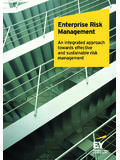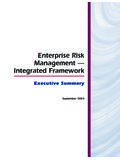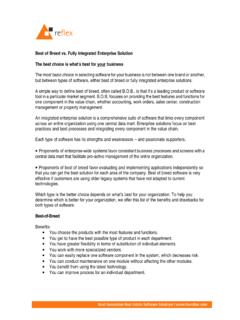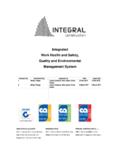Transcription of Working platforms (non-integrated) on forklift …
1 Health and Safety Executive Working platforms (non- integrated ) on forklift trucks Guidance Note PM28 (Fourth edition). This guidance is for users, suppliers and hirers of non- integrated Working platforms . There are restrictions on the circumstances in which non- integrated Working platforms can be used. Also, non- integrated Working platforms do not come under the Machinery Directive and should not be CE marked. There is a variety of equipment available for work at height, including scaffolding, tower scaffolds, mobile elevating work platforms (MEWPs), staircases, platforms and portable ladders. The selection and use of an appropriate and suitable method of access will depend on the nature of the task to be carried out, the frequency of occurrence, the duration of the work and the availability of equipment. forklift trucks are primarily intended for lifting materials and not people. However, they can be used with Working platforms to allow people to work at height in exceptional circumstances only.
2 This guidance explains when this may be appropriate. The guidance also provides advice on identifying appropriate Working platforms and forklift truck combinations, how they can be used safely together and necessary design characteristics for Working platforms for their safe use. Contents Introduction 2. Part 1 Guidance 4. Selecting a suitable truck 4. Use 5. Design 7. Permissioning control Working platforms 10. Very narrow aisle (VNA) trucks 11. Part 2 The law 11. Health and Safety at Work etc Act 1974 11. Supply of new equipment 11. Provision and Use of Work Equipment Regulations 1998 (as amended) 12. Lifting Operations and Lifting Equipment Regulations 1998 (as amended) 12. Work at Height Regulations (WAHR) 13. References and further reading 14. Further information 15. Page 1 of 15. Health and Safety Executive Introduction 1 There is a variety of equipment available for work at height, including scaffolding, tower scaffolds, mobile elevating Working platforms (MEWPs), staircases, platforms and portable ladders.
3 The selection and use of an appropriate and suitable method of access will depend on the nature of the task to be carried out, the frequency of occurrence, the duration of the work and the availability of equipment. 2 In many workplaces people need temporary access to work at height, particularly for maintenance activities. Working at height is a high-risk activity and the planning, selection and use of a safe means of access and Working area is important. This guidance helps users and suppliers to meet their legal duties by providing advice on identifying appropriate Working platform and forklift truck combinations, how they can be used safely together and necessary design characteristics for Working platforms for their safe use. 3 Primarily, forklift trucks are intended for lifting materials and not people. However, they can be used with Working platforms to allow people to work at height. It is generally accepted that, in conjunction with a forklift truck, an integrated Working platform (paragraph 8) provides a higher level of safety than a non- integrated type (paragraphs 7 and 9).
4 Nevertheless, a non- integrated Working platform may be used when it provides a safer means of access than, for example, improvised stairs or platforms or a ladder that would otherwise be used and it is impracticable to use an integrated Working platform. 4 Examples of forklift trucks fitted with platforms are given in Figures 1 3. Figure 1 Counterbalance truck with Figure 2 Very narrow aisle (VNA) truck with non- integrated Working platform permissioning control Working platform Figure 3 Variable reach truck with non- integrated Working platform Working platforms (non- integrated ) on forklift trucks Page 2 of 15. Health and Safety Executive 5 integrated Working platforms on forklift trucks, MEWPs, Working platforms with independent movement (ie variable configurations) and Working platforms on tractor front-end loaders are not covered by this guidance. Definitions 6 Purpose-built access equipment' means equipment that, by design, is intended to be used by people to allow them to work at height.
5 7 Non- integrated Working platforms ' are attachments for use in conjunction with forklift trucks to elevate people so they can work at height, but they have no controls in the platform that allow someone in the platform to control the platform lift height or move the truck; ie all truck and Working platform movements are controlled by the truck operator. 8 integrated Working platforms ' are attachments with controls that are linked to and isolate the truck controls so that only someone in the platform can control the platform lift height and truck movements. 9 Permissioning control Working platforms ' are non- integrated Working platforms with hold-to-run controls that link to and nullify the truck lift/lower and traction controls until the controls in the platform are actuated by someone in the platform; ie adjusting platform height or truck movement can only occur by the truck operator operating the truck controls when the platform controls are held by an operator in the platform.
6 10 Actual capacity (masted trucks)' the maximum weight the truck can lift to maximum lift height and specified load centre as marked on the truck's capacity/. rating plate. 11 Actual capacity (variable reach trucks (telehandlers))' the maximum weight, at the specified load centre, that can be lifted to the maximum lift height or to the maximum forward reach, whichever is the lower. Occasional use 12 Regulation 7(2)(b) of the Work at Height Regulations 20051 places a duty on employers to select the most suitable work equipment for the task to be carried out regardless of the duration of the task. Nevertheless, it is foreseeable (but unacceptable) that people will often use unsafe methods of access to work at height for short duration and occasional tasks. For example, a substantial number of serious accidents occur when people are lifted on the forks or buckets, pallets or stillages placed on the forks of forklift trucks.
7 To encourage safer Working practices, in these exceptional circumstances, occasional use of non- integrated Working platforms with forklift trucks is allowed in the UK in accordance with this guidance. This occasional use is allowed in the UK but may not be allowed in some other EU member states. As such, there is no free movement of non- integrated Working platforms throughout the EU and they must not be CE marked. 13 Examples of occasional use are: non-routine maintenance tasks for which it is impractical to hire in purpose-built access equipment;. the replacement of light fittings in high-rise warehouses if the task is not carried out as part of periodic maintenance operations;. Working platforms (non- integrated ) on forklift trucks Page 3 of 15. Health and Safety Executive tasks that would otherwise be carried out using less safe means of access such as ladders, because it is impractical to hire in purpose-designed people- lifting equipment due to the short duration and occasional nature of the task, eg clearing a blocked gutter.
8 Checking on high-level damage to racking suspected of causing an immediate risk or checking on the condition of damaged roof lights. 14 Routine or planned tasks, particularly those associated with production or pre- planned activities such as periodic maintenance or stocktaking, are not exceptional circumstances and are therefore not examples of occasional use. Generally, non- integrated work platforms do not provide as high a level of safety as purpose-built access equipment. Consequently, forklift trucks fitted with non- integrated Working platforms are not suitable for order picking, routine maintenance or the transfer of goods or people from one level to another. 15 The design safety of industrial trucks is covered by European standards2 that apply to specific truck types intended for materials handling. The design of MEWPs for lifting people is covered by BS EN Consequently, truck/ integrated Working platform combinations that comply with both industrial truck and MEWP standards or equivalent give a higher level of safety than non- integrated platforms and are not restricted to use in exceptional circumstances.
9 Part 1 Guidance Selecting a suitable truck Truck/platform compatibility 16 It is essential that the Working platform is compatible with the truck on which it is used. Before any combination is used for the first time the Working platform and truck manufacturer/supplier must be consulted. It is particularly important to ensure that: the truck/ Working platform combination has adequate stability under all circumstances in which it is intended to be used;. the platform can be securely attached to the truck;. people on the platform cannot reach hazardous moving parts or controls on the truck. 17 The weight of the platform together with its load of people, tools, materials etc should be not more than half of the actual capacity of the truck (ie actual capacity for materials handling) with which it is intended to be used at the rated load centre distance, maximum lift height and maximum outreach in the case of telehandlers and reach trucks.
10 The actual capacity is the capacity of the truck when equipped with any specified attachments, such as side shift and, when carrying out maintenance work, any items or parts placed in the platform add to the overall weight on it. For very narrow aisle (VNA) trucks with elevated operator position and secondary load elevating mechanism, the maximum lift height should be the maximum lift height of the truck with the auxiliary mast fully raised. Method of securing 18 The user must ensure that, in accordance with the platform and truck manufacturer's recommendations, the platform is positively locked onto the truck with which it is to be used (paragraphs 44 and 48). Working platforms (non- integrated ) on forklift trucks Page 4 of 15. Health and Safety Executive 19 If the platform is fork mounted then the fork arms on the truck must preferably extend fully into the fork pockets. If this is not possible, they must extend to a distance of at least 75% of the platform length measured parallel to the axes of the fork arms.
















